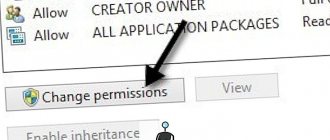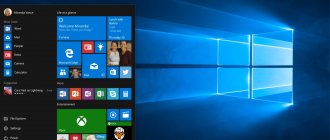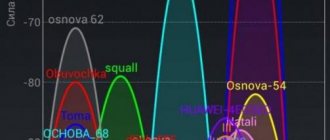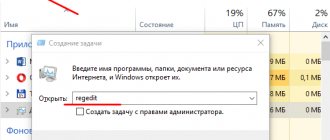The explorer.exe process, also known as Explorer, is a core part of the Windows 10/8.1/7 operating system and serves to improve the graphical Explorer shell for switching various folders and files. For example, with this process we can open folders, copy and delete files. Imagine if you had to do everything through the command line? In fact, this is how the explorer.exe process appeared.
Explorer (explorer.exe) is also responsible for the taskbar shell and start menu, which can crash and not work over time. For example, when you click on the “Start” or “All Settings” button, nothing happens and these buttons are not clickable. In this situation, restarting Explorer.exe in Windows will help. If you made any changes to the Explorer interface or the registry, they will appear only after a reboot, but you can simply restart the explorer.exe process itself without restarting the computer.
It may be that when your PC works all the time, only going into sleep mode without turning off and rebooting, then the explorer.exe process can load a lot of memory, and restarting the computer will help fix this problem. Explorer.exe is not a virus, but malware can disguise itself as this process name and load your system. The file itself is located in the path C:\Windows\explorer.exe, if it is in a different location, then it is a virus.
Also, this process may crash, hang, be unresponsive and show various error messages such as “System call error”, “Application error”, “System buffer overflow error” and other errors related to corruption of system files that include to explorer.exe. Let's look at all the possible solutions to fix errors related to explorer.exe in Windows 10/7/8.1.
How to restart Explorer.exe in Windows 10/8.1/7
This method will help in most cases to correct errors with the display of the interface, unclickable buttons and other errors associated with Explorer. Press the keyboard shortcut Ctrl+Shift+Esc to open the task manager. In the “Processes” tab, find the name “ Explorer ”, right-click on it and select “ End task ”.
Your desktop interface will disappear, don't be alarmed. In Task Manager, click on the “ File ” tab > “ Run new task ” > type explorer.exe and click OK.
Solution 7: Use Registry Editor
If none of the solutions worked for you, then some registry changes may allow the affected user to overcome the File Explorer issue.
Warning: Proceed at your own risk, as editing the system registry requires a certain level of knowledge and, if not done properly, may cause irreparable damage to your system/data.
First, you must create a backup of your system registry. Then launch the Run command window (by pressing Windows + R keys) and type "RegEdit". Then press Ctrl+Shift+Enter to run Registry Editor as Administrator and check if any of the following registry changes solved your problem.
Set the shell key to Explorer.exe
- Go to the following: Computer HKEY_CURRENT_USER SOFTWARE Microsoft Windows NT CurrentVersion Winlogon
- Then in the right pane, double-click the Shell section and set its value to the path to Explorer.exe. Usually the path is below (if the key is not there, create a New > DWORD (32-bit) value and set its name in Shell and set its value to the path below): C: Windows explorer.exe Set the shell to the explorer path in HKCU
- Now reboot the system and check if the File Explorer issue is resolved.
- If not, launch Registry Editor and navigate to the following path: Computer HKEY_LOCAL_MACHINE SOFTWARE Microsoft Windows NT CurrentVersion Winlogon
- Now in the right pane, make sure the Shell key is set to explorer.exe and then restart your computer to check if the Explorer issue is resolved. Set the Shell value for Explorer.exe in HKLM
- If not, then launch Registry Editor and navigate to the following: Computer HKEY_CURRENT_USER SOFTWARE Microsoft Windows NT CurrentVersion Winlogon
- Now in the right pane, remove the Shell key and reboot the system to check if the problem is resolved.
Remove the Explorer.exe key
- Navigate to the following: Computer HKEY_LOCAL_MACHINE SOFTWARE Microsoft Windows NT CurrentVersion Image File Execution Options
- Then, in the left pane, right-click the Explorer.exe folder and select Delete. Delete Explorer.exe from the Image File Execution Options
- Now confirm deleting the key and restart your computer to check if the File Explorer issue is resolved.
Remove download key
- Navigate to the following: Computer HKEY_CURRENT_USER SOFTWARE Microsoft Windows NT CurrentVersion Windows
- Now in the right pane, right click on the Download button and select Delete.Delete Download Key in HKCU
- Then confirm deleting the key and restart your computer to see if File Explorer works.
Use the advanced command line to add registry keys
- If none of the registry changes fixed the problem, run one by one from an elevated command prompt: reg add "HKLM Software Microsoft Windows NT CurrentVersion Winlogon" /v "Shell" /t REG_SZ /d "explorer.exe" /f reg add” HKLM Software Microsoft Windows NT CurrentVersion Winlogon “/v” Userinit “/t REG_SZ /d” C: Windows System32 userinit.exe, “/f reg add” HKLM Software Wow6432Node Microsoft Windows NT CurrentVersion Winlogon “/v” Shell “/ t REG_SZ /d" explorer.exe "/f reg add" HKLM System CurrentControlSet Control Session Manager "/v" BootExecute "/t REG_MULTI_SZ /d" autocheck autochk * "/f reg add" HKLM System CurrentControlSet Control Session Manager "/v ” SETUPEXECUTE “/t REG_MULTI_SZ/d” “/f
- Then reboot and check if File Explorer is working normally.
If the problem still exists, check if adding Explorer.exe (from the C:Windows folder) to your startup folder (%appdata%Microsoft Windows Start Menu Programs Startup) solves the problem. If not, check to see if performing a repair install (or update patch) on your system solves the problem. Otherwise, you may have to restart your computer or perform a clean installation of Windows.
Fix various errors with Explorer Exporer.exe in Windows 10/8.1/7
1. If you have cloud clients installed, such as OneDrive, Yandex Disk and others, then disable them for a while and check if the problem is resolved.
4. Open “Startup” programs in the task manager and disable everything unnecessary (torrent, third-party programs, etc.).
5.
Open a command prompt as an administrator and enter the commands one by one, waiting for the process to finish after each one.
Preliminary actions
Before installing or disabling the program, be sure to remove the browser shortcuts located on the desktop, the Start menu, and the Taskbar located at the bottom of the desktop. Then remove the program from startup. The easiest way to do this is to launch the command line and enter the appropriate command in it. How to do it? Very simple:
- Press the combination Win+R;
- Write “msconfig” in the line;
- In the dialog box that appears, open the “Startup” tab;
- Look through the list and uncheck the boxes next to the programs you do not need;
- Close Internet Explorer.
If the reason is annoying advertising, then read the article on how to remove advertising from your browser.
Why won't my desktop load? Solution to the problem!
In the evening after work, as usual, I sit down at the computer to check my email.
I turn on the computer - everything loads, Windows XP SP3. I was thinking about something while waiting for the OC to load, and after about 10 minutes I realized that the download would not take place. There is a screensaver on the monitor and nothing more.
I think we've finished the game











